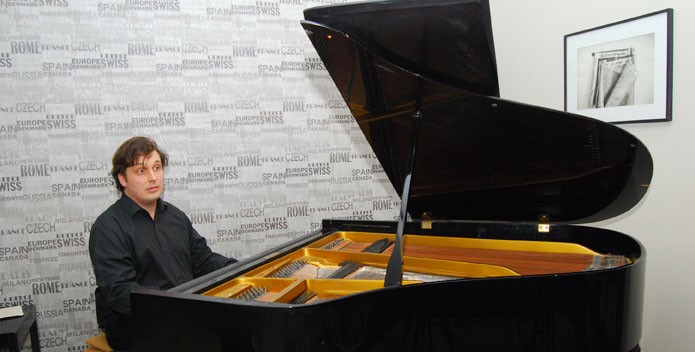
An hour and a half of classical music from the works of some of the greatest composers by Caspar Frantz at Annemarie-Shimmel-Haus

Annemarie-Shimmel-Haus hosted a piano recital at its premises last week in which Caspar Frantz played four pieces for about an hour and a half of classical music from the works of some of the greatest composers of that tradition -- Bach, Mozart and Schumann.
Piano is not a very old instrument for in the eighteenth century music was created by action of hammers on strings. The most important features of the instrument were the way in which gradations of force in the fingering could produce contrast between soft and loud production of notes. In Germany, the idea was taken up by the organ builders Gottfried and Silbermann and demonstrated to Bach who was not impressed, nor was Voltaire who declared the pianoforte an ironmonger’s invention compared with the harpsichord.
The earliest instruments were for some time referred to as pianoforte and the name is frequently used today to distinguish the type known to Mozart and Beethoven before the development of the more powerful models whose metal frames could stand up to the repeated hammerings against the strings. Most keyboard instruments had traditionally been made with horizontal strings as with square piano or the grand piano. Upright piano fortes were introduced by John Hawkins.
It is rare that western classical music concerts are held in this country. Even in Europe and America, it is becoming niche musical activity with the centre stage being occupied by popular musical expression, thriving on its eclectic nature and drawing in bits and pieces from a number of sources from round the world. As is the wont with classical traditions all around the world, including in the west, the major effort in this age of great media explosion is to keep and maintain the purity of sound and the peculiarity of intonation.
The Germans have made a massive contribution to the development of western classical musical tradition and a large number of great composers hail from Germany or German-speaking areas. It thus becomes their responsibility to insist on playing and creating the sounds that are very rich musically and are not overwhelmed by experimentation which has characterised all forms of art including music in the twentieth and now the early part of the twenty first century.
From the information that was circulated at the concert, the German pianist Caspar Krantz has been playing the piano from the age of seven. He completed his post graduate studies from Berlin and received further support with intense collaboration with Renate Kretschmar-Fischer. He received the first prize at the German Jugend musiziert, has held music scholarship and is a fellow of the Villa Musica and the Horst Rahe Foundation Rostok. He has performed in Germany and abroad, in major Festivals, including the Festspiele Mecklenburg-Vorpommern, Schleswig-Holstein Music Festival, Festspiele in Schwetzingen, Ravinia Festival, Ludwigsburger Festspiele, Schwarzwald Festival, Beethovenfest in Bonn, Gstaad Festival, Septembre Musical Montreux, Festival de Pollenca, and at the IMS, Prussia Cove.
He has also appeared with orchestras such as the Kiel Philharmonic, Polish Chamber Philharmonic, Rostock Philharmonic, Stralsund Philharmonic, Neue Philharmonie Westfalen, Iasi Moldova Philharmonic and the prestigious Young Soloist Ensemble Kaleidoskop from Berlin. Along with Julian Arp and publisher Johannes CS Frank, Artistic Director of the Zeitkunst Festival for contemporary Literature and Chamber Music, Berlin he made two recordings highly acclaimed by the German and international press: first, a recording of Felix Mendelssohn ‘s works for cello and piano together with Julian Arp for the label Genuin, Leipiz, as well as Piano Concertos by Joseph Haydn for the Label ARS with Ensemble Kaleidoskop.
While the organ was the instrument of the church in clubs across the subcontinent, piano was used to play tunes for the purpose of dancing.
With the rise of popular theatre in the Indian subcontinent in the nineteenth century, a greater portion of music especially the background score was created by the western musical instruments. One of the instruments that had also made inroads was the piano. Due to the staccato nature of the sound that it created, it was markedly different from the organ and the harmonium which the local musicians could adapt according to their own musical taste.
Gradually with the advent of the talkie, piano started to play a more important role in orchestration of recorded music but its more significant presence was in films where playing the piano, both by the hero and heroine, was considered to be the high point of culture. In the homes of well to do Indians, piano became a regular piece of decoration or furniture, especially in the drawing rooms, even if no one in the family knew how to play it.
Girls who went to English medium schools, especially convents, were given a smattering of music lessons on the piano by the nuns and some who ventured to get college education took some lessons by a private tutor at home for acquiring it as a social grace. Before the introduction of the guitar in the latter half of the twentieth century, piano was seen as the most noticeable instrument which did not originate here.